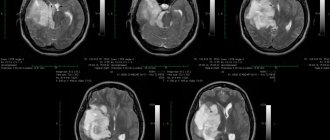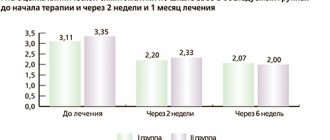Diseases of the peripheral nervous system
Neurological Department Peripheral nervous system
- a conventionally distinguished part of the nervous system, the structures of which are located outside the brain and spinal cord, including the cranial nerves, spinal nerves and nerve plexuses.
These nerve formations deliver impulses from the central nervous system (CNS) directly to the working organs - muscles and information from the periphery to the CNS. The human peripheral nervous system does not actually have the same protection as the central nervous system, so it can be exposed to toxins and also be damaged mechanically.
Causes of defeat:
- infections;
- intoxication;
- vitamin deficiencies;
- circulatory disorders;
- injuries and other factors.
Classification of diseases of the peripheral nervous system:
1. According to the topographic-anatomical principle:
- radiculitis (inflammation of the roots);
- funiculitis (inflammation of the cords);
- plexitis (inflammation of the plexuses);
- mononeuritis (inflammation of peripheral nerves);
- polyneuritis (multiple inflammation of peripheral nerves).
2. By etiology:
- infectious;
- infectious-allergic (for childhood exanthema infections: measles, rubella, etc.);
- toxic;
- allergic (vaccinal, serum, etc.);
- dysmetabolic (with vitamin deficiency, endocrine diseases (diabetes mellitus), etc.);
- discirculatory (for rheumatic and other vasculitis);
- idiopathic and hereditary (neural amyotrophy of Charcot-Marie, etc.);
- compression-ischemic lesions of individual peripheral nerves,
- vertebrogenic lesions (bone, disc, joint, muscle and tendon-ligament formations).
3. According to pathogenesis and pathomorphology:
- neuritis (radiculitis);
- neuropathy (radiculopathy);
- neuralgia.
Group of polyneuropathies (neuropathies)
includes vascular, allergic, toxic, metabolic damage to the peripheral nervous system, as well as damage caused by the influence of various physical factors - mechanical, temperature, radiation.
Neuralgia
– these are painful sensations in the area of innervation of certain nerves and the formation of trigger zones of the skin and mucous membranes, irritation of which, for example, touch causes another attack of pain. In the intervals between attacks, neither subjective nor objective symptoms of irritation or loss of function of the affected nerve are observed.
Diagnosis and treatment of diseases of the peripheral nervous system:
Methods for diagnosing diseases of the peripheral nervous system are aimed at identifying and correcting the underlying disease (for example, damage to peripheral nerves due to diabetes, alcoholism, etc.).
Treatment of these diseases includes medication, non-drug and surgical treatment.
Drug therapy
is aimed at correcting the underlying disease, relieving pain and restoring nerve function.
Non-drug therapy includes the use of physiotherapeutic treatment methods, the selection of which depends on the specific pathology, the severity of the process and concomitant pathology: Surgical treatment methods are used:
- with long-term persistent neurological defect and ineffectiveness of conservative therapy;
- in acute conditions and the presence of absolute indications for surgical treatment.
Treatment of diseases of the peripheral nervous system, as well as therapy of diseases of the central nervous system, must be carried out immediately.
Guillain-Barre syndrome
This is one of the most severe neurological diseases, which in every third patient requires treatment in the intensive care unit at the height of the disease. The term refers to a rapidly progressing neuropathy characterized by flaccid paralysis in the symmetrical muscles of the limbs with sensory and autonomic disturbances. The condition develops acutely, usually after colds and other infections. However, with adequate treatment, complete recovery is possible.
Causes:
Guillain-Barre disease is usually classified as an autoimmune disease.
Having coped with the infection, the human immune system does not recognize this and begins to attack its own body, in particular the nervous tissue. Cells of the immune system produce antibodies that lead to demyelination, that is, damage to the myelin sheath of the nerves. As a result of autoimmune processes, axons, the processes involved in the innervation of muscles and internal organs, can also be damaged. The first signs of the disease are recorded one to three weeks after such infectious diseases as:
- Viral enteritis.
- Respiratory infections (ARVI).
- Cytomegalovirus infection.
- Infectious mononucleosis.
- Herpetic infection.
Kinds:
Guillain-Barré syndrome is usually divided into two types - demyelinating and axonal; the first variant of damage to peripheral nerves is more common.
- Demyelinating
. Only myelin sheaths are involved in the pathological process; destruction of axon cylinders is not detected. This leads to a slowdown in the speed of impulse conduction, which provokes the development of reversible paralysis. Pathological changes affect the anterior, less often the posterior roots of the spinal cord; damage to other parts of the central nervous system is also possible. The demyelinating type is considered a classic variant of the syndrome.
- In the axonal variant, the axial cylinders of the axons are also affected, which leads to the development of severe paresis and paralysis. The axonal type
of polyneuropathy is considered more severe, after which motor functions are not fully restored.
Diagnostics:
The disease can be suspected already by questioning and examining the patient. Guillain-Barré syndrome is characterized by symmetrical damage to the extremities and preservation of the function of the pelvic organs. Of course, there are also atypical signs of the disease, so for differential diagnosis it is necessary to conduct a number of studies.
- Electromyography – determination of the speed of impulse transmission along nerve fibers.
- A spinal tap can detect protein in the cerebrospinal fluid. Its content increases a week after the onset of the disease and reaches its peak by the end of the first month of the disease.
- EGC can detect arrhythmias.
- Blood tests show an increase in ESR and white blood cell count without other signs of infection.
Treatment:
Treatment of Guillain-Barré syndrome is divided into two complementary types: nonspecific and specific therapy.
Treatment of patients with acute development of symptoms, respiratory dysfunction, severe cardiac arrhythmias begins with nonspecific therapy. The patient is admitted to the intensive care unit. In the phase of increasing symptoms, continuous monitoring of respiratory function and cardiac activity is carried out. Specific therapy includes the administration of immunoglobulin and plasmapheresis.
- Immunoglobulin is prescribed intravenously. This is especially necessary for those patients who cannot move without assistance or have difficulty swallowing and breathing.
- Plasmapheresis is prescribed for moderate to severe disease. Its use significantly speeds up recovery time and prevents the development of residual effects. In mild cases of the disease, plasmapheresis is not used.
- For arrhythmias, increased blood pressure and other autonomic disorders, symptomatic therapy is used.
In case of paralysis, bedsores and pneumonia are prevented by turning the patient over, treating the body, and performing a massage.
During the rehabilitation period, it is necessary to use sets of physical exercises, physiotherapy, and massage courses. If you have a speech disorder, sessions with a speech therapist are necessary. Information for patients and their relatives
Rules for hospitalization
Services and prices of the department
Causes of polyneuropathy
Acute polyneuropathy is provoked by a number of different factors. Most often, the acute form of the disease occurs under the influence of bacterial infections, which are accompanied by toxicosis . Also, the causes of acute polyneuropathy are identified as an autoimmune reaction, poisoning, the use of a number of medications, in particular antibiotics , as well as those drugs that are used during chemotherapy. The disease can develop in people suffering from cancer, which is accompanied by nerve damage.
Chronic polyneuropathy develops under the influence of diabetes mellitus, systematic alcohol consumption, decreased thyroid function, liver dysfunction, and a lack of vitamin B12 or excess vitamin B6 .
Most often today, the chronic form of the disease develops as a consequence of constant high blood sugar levels in a patient who does not take measures to reduce it. In this case, a separate form of the disease is determined - diabetic polyneuropathy . When establishing a diagnosis and prescribing treatment for polyneuropathy to a patient, the doctor must take into account those factors that influenced its development.
Symptoms of polyneuropathy
The main clinical manifestation of polyneuropathy is the presence of motor disorders, as well as sensory and autonomic disorders. In most cases, polyneuropathy affects the longest nerve fibers. That is why the symptoms of the disease initially appear in the distal parts of the extremities. Due to the diffuse nature of damage to nerve fibers, a symmetrical manifestation of symptoms is noted.
During the development of polyneuropathy in a person, a violation of sensitivity occurs, with the manifestation of vegetative and motor symptoms. The most common motor dysfunction in a patient with polyneuropathy is paresis , accompanied by hypotension and muscle wasting. Paresis is most often observed in the extremities. In severe cases of the disease, the muscles of the trunk and skull are involved in the process. It is customary to distinguish between two types of symptoms in polyneuropathy: negative and positive symptoms. Negative symptoms are hypoesthesia, weakness and subsequent muscle weakness, sensitive ataxia (coordination of movements is impaired), weakened gastrointestinal motility, weak pulse, strong or weak sweating, impotence . Positive symptoms are tremor, neuromyotonia, fasciculations, paresthesia, pain and restless legs syndrome, high blood pressure, tachycardia , intestinal colic.
Sensory disturbances in polyneuropathy can be very diverse. Thus, sensitivity can either decrease or be completely absent. Paresthesia (tingling sensation and goosebumps), as well as pain of a different nature, are periodically observed. Thus, painful sensations can manifest themselves as a response to a non-painful stimulus. In addition, pain may be spontaneous.
Also a sign of polyneuropathy is neuralgia , manifested by pain at the site of innervation of the nerve. As a rule, it is usually a piercing or shooting pain. Causalgia also appears . This is a burning and persistent pain that develops at the site of innervation of the nerve due to its damage. In this case, various autonomic disorders often develop, and tissue nutrition is disrupted.
Another manifestation of polyneuropathy associated with the autonomic nervous system is erectile dysfunction in men, which is characterized by erectile dysfunction and the inability to perform normal sexual intercourse.
Diagnostics
With the right approach to establishing a diagnosis, it is not difficult to determine the presence of polyneuropathy in a person. As a rule, specialists have difficulty establishing the etiology of the disease. To get an accurate picture, the patient is prescribed a clinical analysis of blood and urine, determination of the levels of glucose, urea, and liver enzymes in the blood. Chest radiography and plasma protein electrophoresis are also performed. In some cases, patients are prescribed an ultrasound of the abdominal cavity. If there are indications, it is possible to conduct instrumental studies of the genitourinary system, gastrointestinal tract, lumbar puncture , and tests for the presence of rheumatic diseases .









